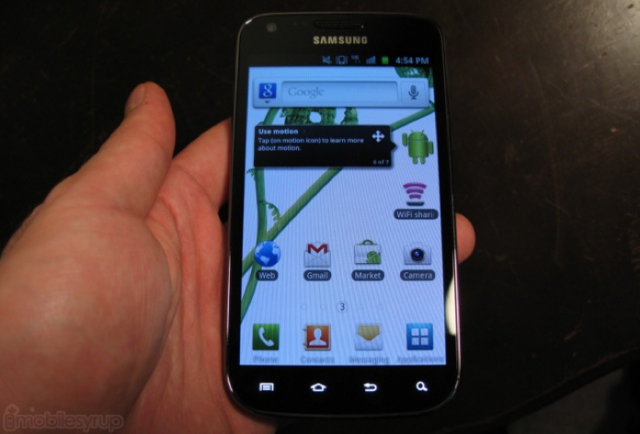
It is likely not a coincidence that the Samsung Galaxy S II X is debuting on Telus mere weeks before the debut of a new iPhone. Its most stately device since the massive HTC Desire HD, the carrier has lacked “superphones” and released devices meant for the back-to-school mainstream consumer segment.
While there is nothing inherently wrong with that strategy, it lead to a six-month space where Rogers and especially Bell were offering superior, albeit more expensive, Android phones. As its competitors used words like dual-core and qHD, focusing on speed, size and might, Telus offered the HTC Status with Facebook integration and the LG Optimus Black with built-in Skype support.
The Samsung Hercules was rumoured for many months to be an American variant of the Samsung Galaxy S II, and has since been confirmed for T-Mobile. When the photos leaked showing it was coming to Telus, Android fans and spurned Telus customers alike shouted for joy.
While it resembles Bell’s Galaxy S II in many ways, there are several aesthetic and internal changes that differentiate, and improve upon, the original.
Specs
– Android 2.3.5 with TouchWIZ 4 overlay
– 4.52” 480×800 pixel Super AMOLED Plus display
– 1.5Ghz dual-core Qualcomm Snapdragon MSM8660 SoC w/ Adreno 220 GPU
– 1GB RAM / 16GB Internal Storage (2GB for apps)
– 8MP back camera / 2MP front camera
– 1080p video capture with anti-shake
– 42Mbps/11.52Mbps Dual-channel HSPA+ speeds
– WiFi a/b/g/n, Bluetooth 3.0, DLNA, WiFi-Direct, dual microUSB/HDMI out MHL port
– Stereo FM radio, native DivX playback
– 1850mAh battery
– 131mm / 67mm / 9.4mm
– 135g
– 850/1700(AWS)/1900/2100 HSPA+ & Quad-band EDGE, Technology 3GPP Release 8 (HD Calling)
Design
The SGS2X, as it will henceforth be named, is slightly wider and thicker than the original. The screen size has been increased to 4.52” from 4.3” but maintains the beautiful, paper-like sharpness that Super AMOLED Plus offers. The resolution stays the same, too, meaning that icons are almost comically oversized, especially if you are coming from an Android device with the same resolution but a smaller screen, like the HTC Desire. You’d think, though, that text at such a size would be blurry, but is in fact extremely sharp, even if the individual letters are bigger than average.
The body is wider than the Galaxy S II, owing more of its lineage to the original i9000 model that Bell released in summer 2010. This time, though, Samsung didn’t skimp on the quality of materials: compared to the Bell Galaxy S II, the SGS2X is robust despite being entirely made of plastic. Its chrome bezel is a bit garish, and a fingerprint magnet, but it’s the sturdy spine that we so longed for in previous models. Because the bezel is rounded and thicker, it is more comfortable to hold for long periods of time, especially for phone calls.
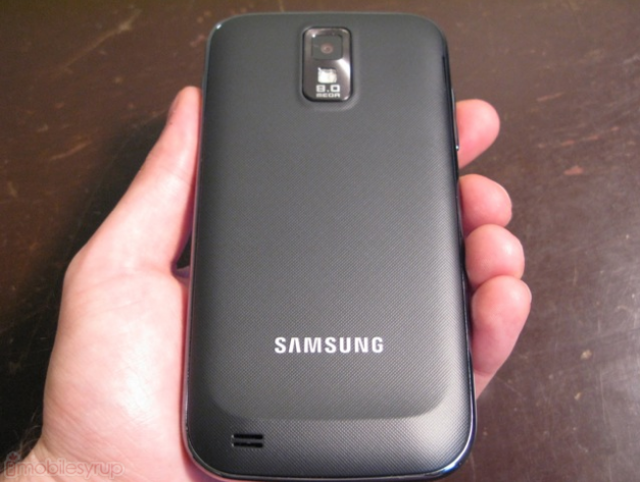
The back of the device is stunning. Simply put, Samsung has designed one of the most attractive battery covers we’ve ever used. While it maintains the textured backing of the SGS2, the X’s pattern is smaller and closer together; it resembles leather, but feels like high quality rubber. Like all Galaxy S variants, the bottom curves out slightly, but this one is more subtle and elegant.
Due to the large size of the display, the device feels right in both portrait and landscape mode. We found the landscape keyboard just the right balance of width and height to type on without mistake or interruption. The body is 135g all told, some 19g heavier than the SGS2, but the extra weight is distributed well, and instead of feeling heavy, we’d argue the original feels light.
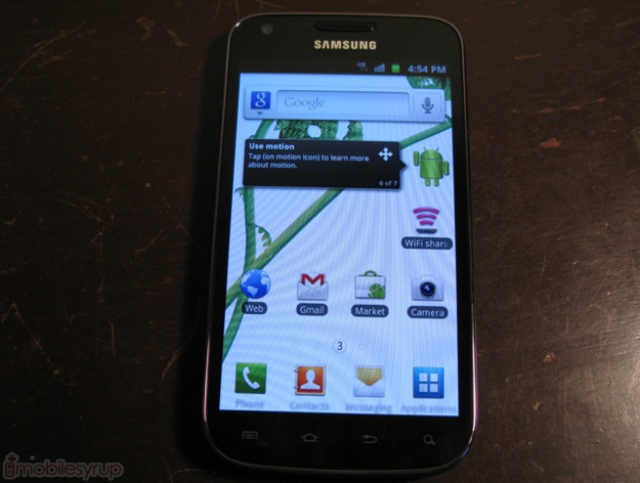
The Display
There is no question that Samsung still holds the crown in terms of display quality. The extra .22 inches certainly brushes against the edge of WVGA fidelity, and we’d have loved to see a few extra pixels on this gorgeous screen, but this is still THE best on the market.
Black levels are perfect — pixels literally don’t turn on unless they’re used — while colours are vivid and, though slightly exagerrated, pleasant to look at. Even more impressive, as we noted in the original’s review, is text, which appears more like reading a piece of paper than any other device we’ve used. This trend continues on the SGS2X despite the size of each letter being slightly larger than on its predecessor.
At this point, though, we think that 4.52” is the largest one should stretch the WVGA resolution. The company just announced an HD version of the Galaxy S II LTE, with a stunning screen resolution of 1280×720, but it likely incorporates the inferior PenTile technology, so we’ll have to see how they compare.
One area that we’d like to see improved is the quality of the glass. Even though both models use Gorilla Glass to cover the screen, protecting it from scratches, we found that after several months of using a Galaxy S II as our daily driver the screen was full of tiny scratches and blemishes. We never found this with the iPhone 4, or any number of other Android devices. While we haven’t seen this issue crop up yet on the SGS2X, and hopefully it won’t, just be cautious if not using a screen protector.
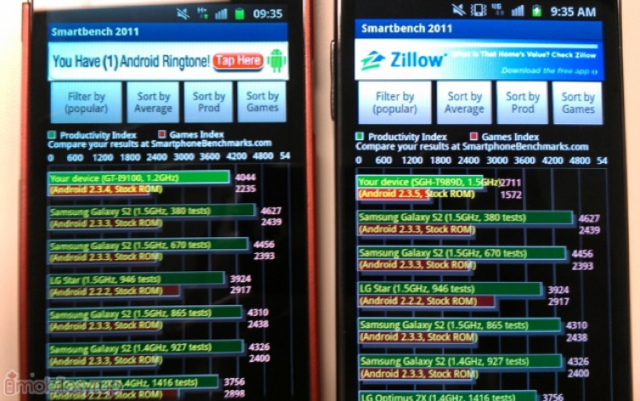
Performance
So, here’s the kicker. The Samsung Galaxy S II X does not use the same processor as the original. It actually uses a Qualcomm Snapdragon MSM8660 processor, similar to the one in the HTC Sensation and Evo 3D. While this is the first Qualcomm processor we’ve seen inside a modern Samsung device, there were rumours bubbling for months hinting that the company may be using nVidia’s Tegra 2 processor.
The Snapdragon processor inside the SGS2X is clocked some 300Mhz faster than the Exynos processor in Bell’s version. However, Samsung’s home-made SoC, with its Mali400-MP GPU is known to be somewhat faster than anything on the market, and in our previous tests blew away the Sensation in synthetic benchmarks. So why the switch to Qualcomm from their admittedly faster home-made chip? It’s all about network speed. In order to reach those astronomical speeds of 42Mbps, twice what the original could pull off, Samsung had to pair the Qualcomm MDM8220 baseband chip with the MSM8660 SoC. Simple as that: there are no baseband chips compatible with the Exynos chipset right now to help achieve those dual-channel speeds, necessitating a move over to Snapdragon.
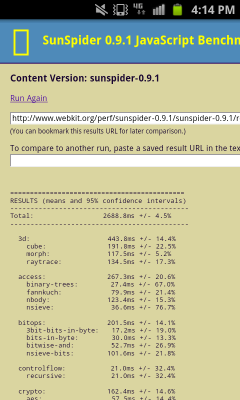
So how does this affect performance? In day to day usage, you’re unlikely to notice a difference. In fact, for single-core non-GPU applications, the SGS2X is likely to be faster merely by virtue of its 20% increase in core clock speed. As a result, we experienced a massive 627ms speed boost in the popular Sunspider Javascript benchmark, from 3316ms to 2689ms. This translated well in general browsing, too: desktop pages loaded extremely quickly and scrolled, panned and zoomed noticeably better than the SGS2.
Synthetic benchmarks didn’t fare as well. Because the SGS2X has the same graphics processing unit as the HTC Sensation and EVO 3D, albeit clocked slightly higher as well, synthetic benchmarks in which the GPU was tested failed to compete with the Bell Galaxy S II.
While Qualcomm’s own Vellamo benchmark was neck and neck, with the SGS2 beating out the SGS2X by a mere 6 points, the venerable, and notably more GPU-focused Smartbench 2011 test suite favoured the Bell GS2 by a wide margin.
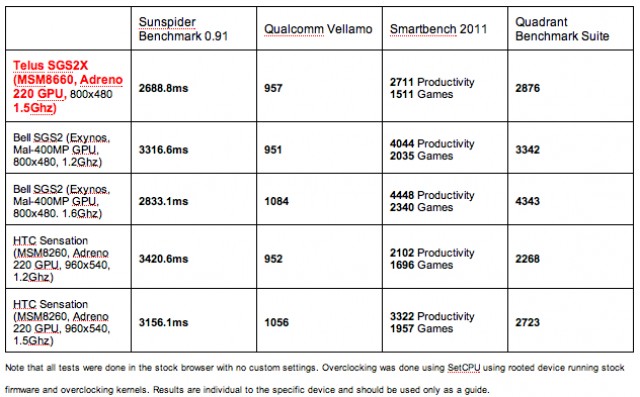
Except for the Sunspider test, the Bell Galaxy S II comes out on top in every benchmark, especially when it comes to more GPU-intensive applications. That being said, the SGS2X holds its own very nicely and in real world settings even if, for some reason, it doesn’t scale as well as the Sensation at the same clock speed. (Note that the Sensation has a screen resolution of 960×540 so graphics-intensive tests must take those extra pixels into account, as tests are run at the phone’s native resolution. We included the Sensation merely for comparison purposes).
However, this brings to bear a couple things. First, that Samsung has optimized its browser for hardware acceleration (affecting the Sunspider tests); second, that Samsung has a conundrum on its hands, as a new device being marketed if not as a successor to the current Galaxy S II, at least a superior option, is inferior when it comes to sheer speed.
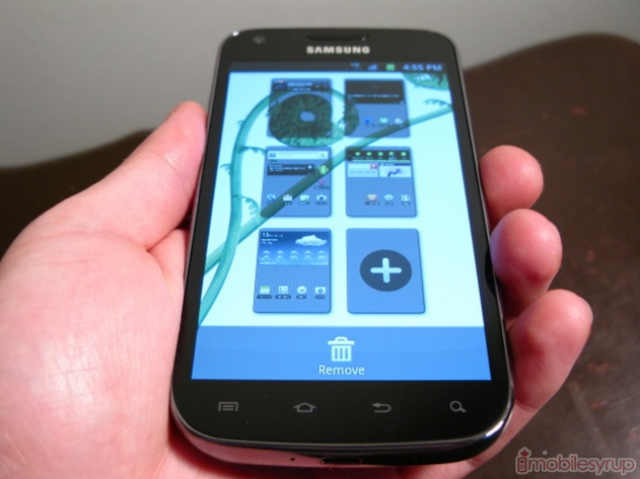
TouchWIZardry
The SGS2X ships with build KI3, which means it was released in the third week of September, 2011. As a result it’s running Android 2.3.5, the next-to-newest compilable version currently available, and possibly the most up-to-date code on any shipping Android product to date (except for the Nexus S and Nexus One).
In terms of differentiation from the original Galaxy S II, there is none. They both run the TouchWIZ 4 skin with its smooth, hardware-accelerated scrolling, austere aesthetic and advanced feature set. Since its release in June, we’ve come to love the simple-yet-powerful launcher.
By default there are five home screens, loaded to the brim with Samsung widgets. There’s a digital clock, a weather applet, a search bar, a news portal along with the icons to the four Samsung Hubs: Reader, Music, Games and Social. Each one represents a tie-in with a third-party company, offering various media to purchase. We appreciate that the Reader application is partly powered by the Canadian e-seller Kobo, which allows you to syncronize existing content to your device. Zinio and PressDisplay offer magazines and news, respectively.
Music is powered by 7Digital, a legitimate contender to iTunes in the digital space. They offer fairly-priced DRM-free tunes that can be downloaded to three devices, though they don’t yet offer a streaming service a la Google Music.
The Social hub consolidates Facebook, Twitter and LinkedIn with your various corporate or private email accounts. It works well, and for light users will suffice as a replacement for individual applications, but we’d recommend going with the services’ respective official apps.

The only “bloatware” to speak of was a GroupOn app, which offers daily deals in your notification bar every morning. Unfortunately you are unable to delete the app, but you can manually turn off deal notifications in the Settings.
In addition to the requisite Google apps such as Gmail, Maps and YouTube we noticed an icon for Google Books on the device, even though the service is not yet offered in Canada. While you can download copyright-free content, it isn’t yet possible to purchase books, but its inclusion makes us hopeful for the future.
We liked the quick toggle icons at the top of the notification bar, and the easy way to place icons on the homescreen through an intuitive grid system that is head and shoulders above the stock Android organization method. And the myriad widgets that Samsung includes for weather, news, and social media? They’re all pretty useful, and gorgeously arrayed on the Super AMOLED screen.
In terms of built-in storage, 13GB or so is available to the user, and is divided between 2GB of application storage, while the rest is allocated as an internal SD card.
For a more in-depth roundup of the features in TouchWIZ 4, see our review of the Bell Samsung Galaxy S II.
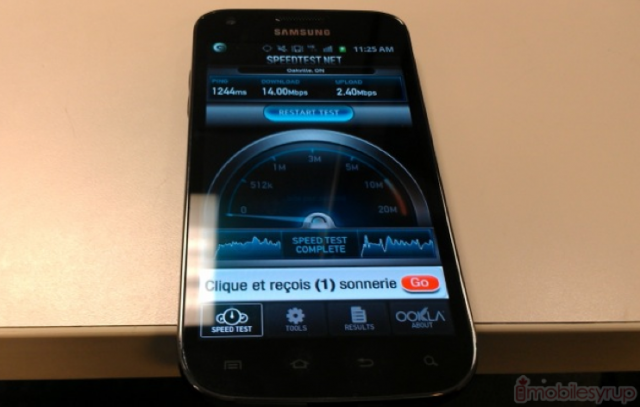
Reception and Network Speed
Let’s go back a second to why Samsung chose to slap a third-party baseband chip in a device that could have seen a home-made part inside. To understand this reasoning, we have to take a look at the last year or so of Canadian network expansion.
As Bell and Rogers turn on their LTE networks, it’s Telus who remains the only carrier advertising speed improvements to its existing HSPA+ network. Granted, Bell and Telus share many cell towers between them, but the Galaxy S II X is the first device in Canada to support Dual Channel HSPA+, which utilizes two distinct 5Mhz channels in either the 850- or 1900Mhz spectrum. Because a single HSPA+ channel theoretically supports 21Mbps, by engaging two for a single transmit we ostensibly double our bandwidth to 42Mbps in the downlink.
We were able to see some ridiculous speeds as a result, with LTE-rivalling results of 14Mbps in the downstream and up to 3Mbps in the upstream. But raw speed has never been an issue for HSPA+ networks, at least not in practice; rather, it is high ping times which truly affect the performance of mobile products. It is not uncommon to see 300+ms ping times to a remote server, which means that it takes almost one-third of a second for that server to respond to our device and send back an acknowledgement. This may not seem like much, but every time you visit a website or initiate a data-based communication, even to a device in the hands of someone sitting next to you, high latency can drastically deteriorate overall network performance.
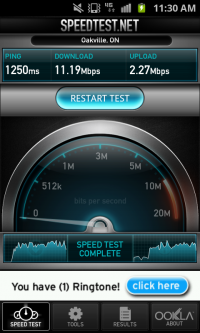
We noticed that in the curious, though admittedly synthetic, Speedtest.net application, higher download speeds translated into significantly higher ping times. When we achieved that result of 14Mbps, it was accompanied by a 1200ms latency time. When we achieved more reasonable results of 3Mbps download, we obtained a more reasonable 105ms ping. Dual-channel doesn’t always mean higher latency, but higher a cell-site utilization means less unobstructed bandwidth is going to be allocated per device, lowering speeds in both the up- and downstream.
In real-world browsing, the extra speed is noticeable. When launching a HD YouTube video over 4G, for instance, not only does it begin almost instantly, but we had none of the buffering hiccups so often experienced over 3G networks. And since we are utilizing two channels, the cumulative bandwidth allows for streaming while background downloading; in other words, you can be download a large file while streaming the latest Bieber album from Rdio.
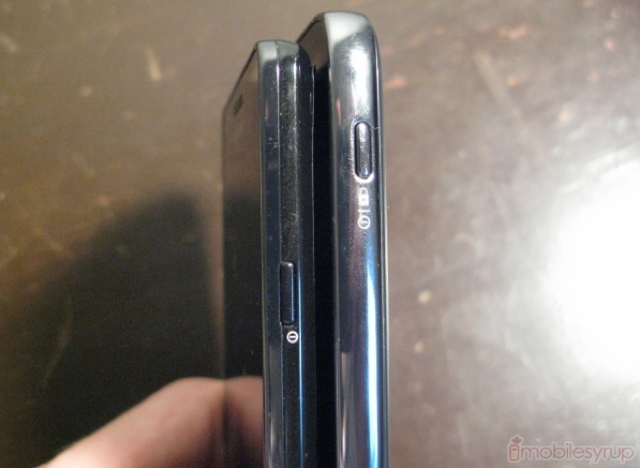
Samsung has never been known for the sharpness of their earpieces, and the SGS2X continues this unfortunate tradition. While we had no issues hearing the other person under ideal circumstances, the maximum volume was too low when walking down a busy street, or when the other person spoke quietly. There is a second noise-cancelling microphone which did successfully filter out external din, the results were underwhelming when compared to the superlative earpieces on the Motorola Atrix or BlackBerry Bold 9900.
In its favour, however, was the excellent cell reception maintained by Telus’ HSPA+ network. We did get a chuckle seeing the 4G icon next to the four reception bars, but like its Galaxy S II brother, the X was a stalwart trooper, finding reception in basements, elevators and even behind concrete. And because the SGS2X comes with built-in WiFi sharing, your excellent reception can be translated into a ubiquitous hotspot.
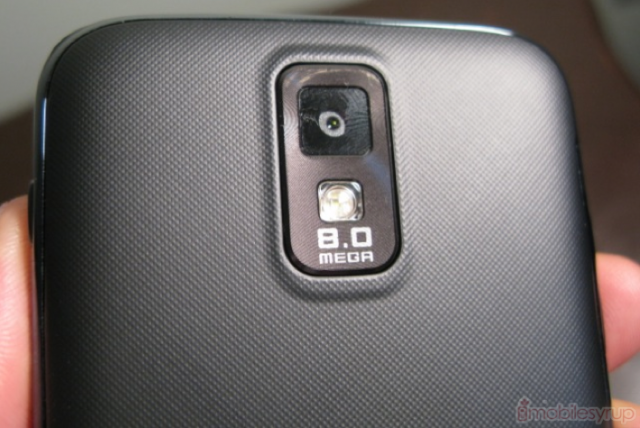
Cameras
The Galaxy S II X comes with the same excellent camera sensor as its brother. Easily incorporating one of the best lens/sensor combos on the market, the 8MP shots that this phone takes will make you leave your point-and-shoot at home. They’re that good.
Colours are vibrant and true, while detail is phenomenal. We found that photos took a fraction of a second longer to process than the Bell version, likely due to the different way the processor renders the image, but shots are virtually instantaneous. The interface is simple and powerful, with the option to customize the left shortcut bar to your heart’s content. If you want the Flash toggle to be on the top, you can put it there; if you want the ability to change photo resolutions with one click, the option is available.
The number of customization options is astounding. There are several Shooting Modes, including face-detecting Smile Shot and red-eye reducing Beauty, while the Action Shot mode produces a fantastic panorama as you follow a single object along a static path. Further confusing things are the myriad Scene Modes which add filters and adjust white balance to suit a particular backdrop. You can shoot in at all times of the day, with Dawn, Sunset and Night modes, in addition to Beach/Snow, Party/Indoor, Fireworks and Fall Colours modes. There is even a Text mode for when you’re trying to turn words into memories.
The 2MP camera on the front delivers excellent, true depictions of your vain self, and with the proliferation of conferencing applications recently released, including Skype, Google Talk and Google+ Hangouts, it can actually be put to good use.
In terms of video capture, the 1080p results from the Galaxy S II line remain unrivalled by any device except Nokia’s N8, which still holds the quality crown. The SGS2X captures h.264-encoded .MP4 files, easily editable with most common software. While many OEMs claim their current high-end devices capture 1080p video at 30fps, the Galaxy S II line is the only one that actually looks like it does. We noticed no slowdown, no dropped frames, only perfect, enviable smoothness. The only thing we’d have liked to see is tap-to-focus in the UI itself, which both Apple and HTC can boast of their software. We found continuous autofocus to be a tad slow and unpredictable, often marring an otherwise perfect shot with a second or two of blurriness.
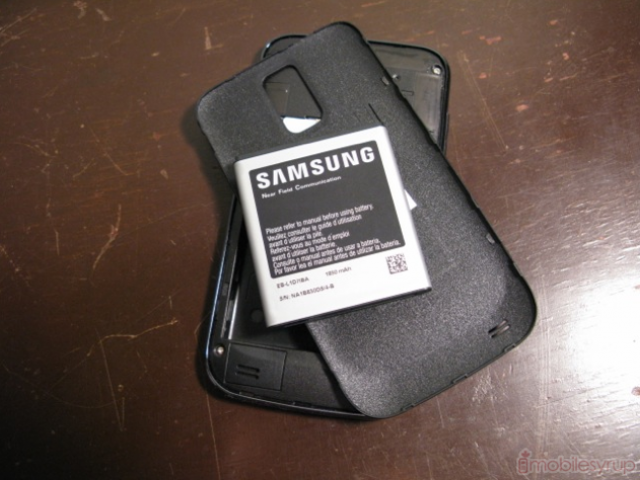
The Galaxy S II X, with its slightly wider and thicker frame, can get away with a beefier battery, and we get 200mAh extra to go along with an improved battery cover and .22” extra screen space.
What we get is a comparatively high-powered, long-lasting Android device. Though the phone generally lasted us most of the day without issue, there would be the occasional time that by 1pm the battery would be down to 25%, and that’s solely due to baseband chip needing more power to utilize the wider pipe. There is no way to we can tell to limit download speeds over 4G, so if you’re downloading large files, streaming lots of movies or photos you’ll notice the battery draining pretty fast. Offloading the bandwidth duties to WiFi, which seems counterintuitive, will do a lot to prolong the daily life of the phone.
That being said, we found the device, like its forebear, to last longer than most other Android devices, and it wasn’t uncommon to go to bed with 15% battery remaining. Unfortunately Samsung has seen fit to include a Battery Full vibration, which usually goes off an hour or two after going to sleep. There doesn’t seem any way to turn this off, barring editing sensitive system files or rooting the device and installing a custom ROM.
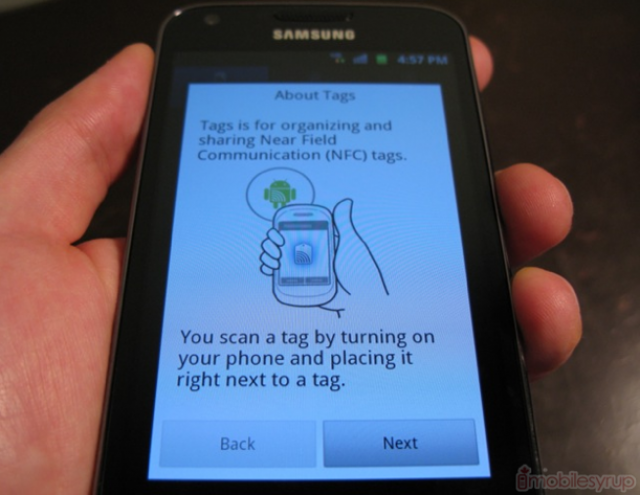
NFC, GPS, OMG
The NFCs are coming! The low-power RFID-like protocol being built into a growing minority of smartphones including the Nexus S and BlackBerry 9900 is meant to help transfer small amounts of data in close quarters. With Google Wallet just launched (not available yet in Canada), the service should grow amongst Android users but it maintains an esoteric and largely inaccessible “future-proof” feature.
Soon, when more devices and retailers are equipped with NFC, safe payment transactions such as paying for your meal or transferring money to a friend, can happen by merely tapping a console or bumping your phone with another. As it stands, there is a Tags application built into the device without much current value.
We’re happy to say that GPS works very well on the Galaxy S II X; we had no issues locking on, and staying connected to, a number of satellites. The large screen works great as a turn-by-turn navigation unit: all you need is a smartphone car mount.
WiFi and Bluetooth, as expected, work as expected and we had no trouble connecting our A2DP-enabled headset to the device for stereo music streaming.
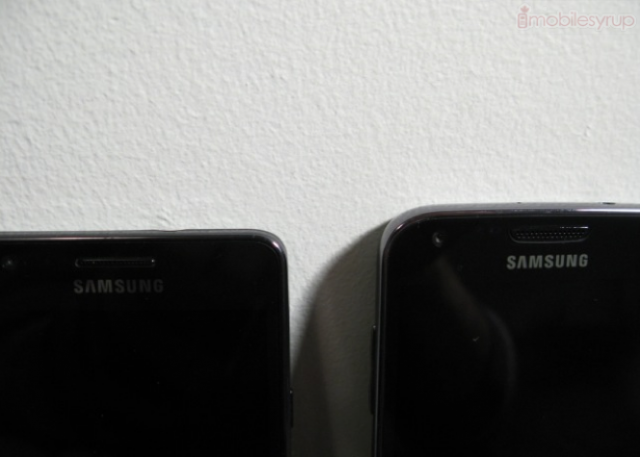
Where It Needs Improvement
Samsung just brought word of the upcoming HD version of the Galaxy S II, which sports a 1280×720 pixel display and a 316PPI compared to a paltry 206PPI on the 800×480 Super AMOLED Plus display. As a result, text tends towards the larger size, even if it’s difficult to see any grain due to the excellent technology behind the display.
What we do know is that the next-generation of Galaxy S devices will have a higher-resolution display, and we’ve already seen the fruits of this on qHD devices like the Motorola Atrix and HTC Sensation. Yes, the Samsung’s screen looks better but fits far less than its higher-res peers.
We also found issue, as we did on the Bell version, with the sound quality coming out of the headphones and speaker on the Galaxy S II X. It has been widely noted that Samsung downgraded the Digital to Analog converter on the GS2 line, utilizing a cheaper Yamaha part over an excellent Wolfson Micro part on the original Galaxy S i9000. After using the Bell GS2 for many months, and the Telus version, I have grown used to the slightly lower fidelity audio coming out of the headphone jack, but that doesn’t mean to say I like it. Practically any other modern headphone jack, from the iPhone to any HTC device, sounds fuller, punchier and less noisy than that of the SGS2.
There are an excessive number of system applications running in the background on the SGS2X. Despite there being 1GB RAM under the hood, only 230MB are accessible to the user on first bootup. While there are essential services, such as media synchronization and background updates, that require a sizable amount of RAM, we’d have liked to see more available to the user for apps.
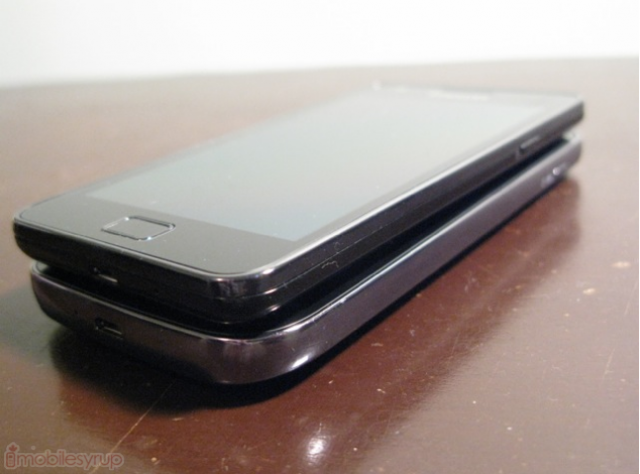
Hacking and Slashing
Even though the device has not been released yet, in a word: yes. With an unlocked bootloader and myriad developers chomping at the bit to develop their own piece of Android ROM history, the Samsung Galaxy S II X is sure to be a very active modders’ device. Add in the fact that this is the exact same model as the one being released on T-Mobile, and you’ve got a recipe for XDA-Developers success.
Just note that Samsung has added what they call a custom kernel counter to the Galaxy S II line. The moment you install a custom kernel, the count starts and your warranty is void. While there are ways around this, you’re on your own once you’re out in the wild. You’ve been warned.
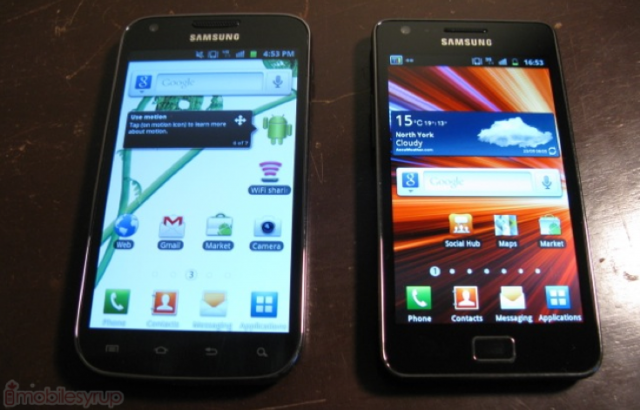
Conclusions
The Telus Samsung Galaxy S II X. TSGSIIX. It’s coming at a very important time for the carrier, who needs a hit phone that will get people talking. Samsung currently has the most cultural cache amongst mainstream users after Apple. After hitting the 10 million sold mark, the Galaxy S II line is a clear hit, and this model is easily its most attractive version (though we haven’t seen the Sprint version, nor the upcoming LTE models for comparison).
As for performance, the rather tiny hit in synthetic benchmarks is a small price to pay for the extra bandwidth obtainable by utilizing Telus’ dual-channel HSPA+ abilities. And, like its future-LTE companions, the battery hit is more than welcome when instantly loading web pages and streaming high quality video over the cellular network.
More than the sum of its individual parts, the Galaxy S II X is one of the most attractive smartphones we’ve ever used. At no time did it feel oversized, clunky or in the way. Its greatest weakness — a relatively low resolution — is also one of its biggest strengths: the screen on this device is stunning.
As a business phone, it not only has the looks but the Exchange chops. If you’re dissatisfied with the stock apps, there are plenty of alternatives in the Android Marketplace, which has just been updated to include film rentals, most of which would look great streaming to the large screen.
While there are some problems with the device, they are mostly minor quibbles that will diminish as you get used to it. Samsung has bested itself, again, and we’re grateful they continue to do so.
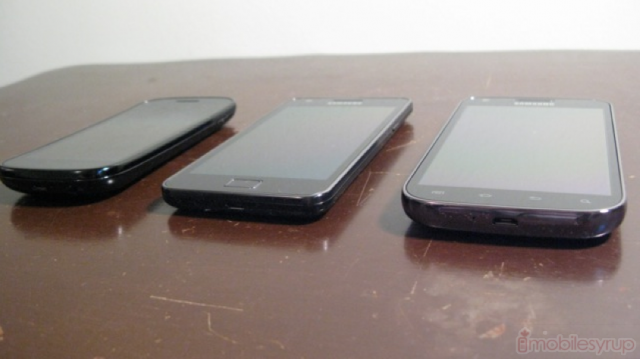
Rating: 9/10
Pros:
– Beautiful, vivid screen that does not pixellate or distort despite the large size
– Excellent build quality, huge improvement over SGS2
– Battery cover is gorgeous and makes the phone easy to grip
– Speed demon: excellent day-to-day software performance
– Bandwidth demon: best HSPA+ scores we’ve ever seen
– Camera is awesome, and the video results are fantastic: leave your P&S at home
– NFC included (thanks?)
– Battery life is better than average
– Android 2.3.5 is smooth as butter
– AWS compatibility means 3G with every GSM carrier in Canada
Cons:
– High bandwidth activity eats battery
– Headphone sound quality is not satisfactory for an expensive smartphone
– Not quite as fast as SGS2 variant in most benchmarks
– Disappointing amount of free RAM (lots of stuff in the background)
– No notification LED
MobileSyrup may earn a commission from purchases made via our links, which helps fund the journalism we provide free on our website. These links do not influence our editorial content. Support us here.




